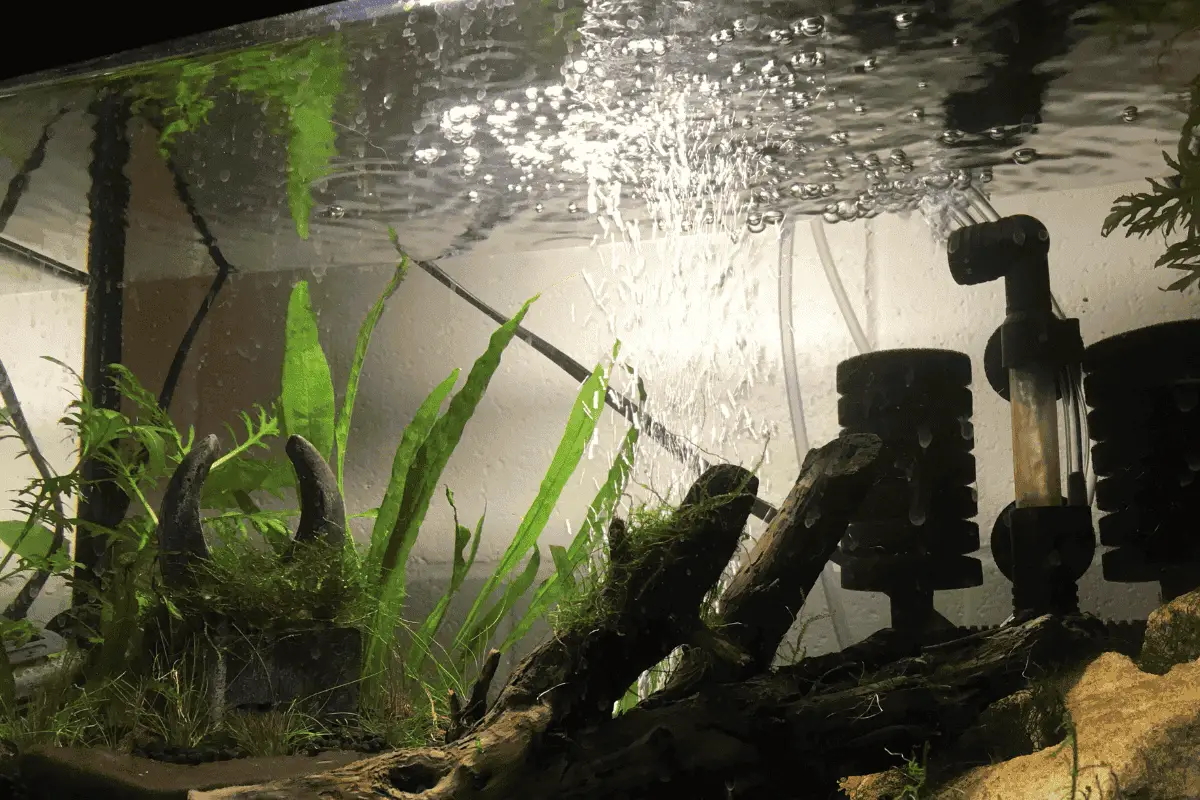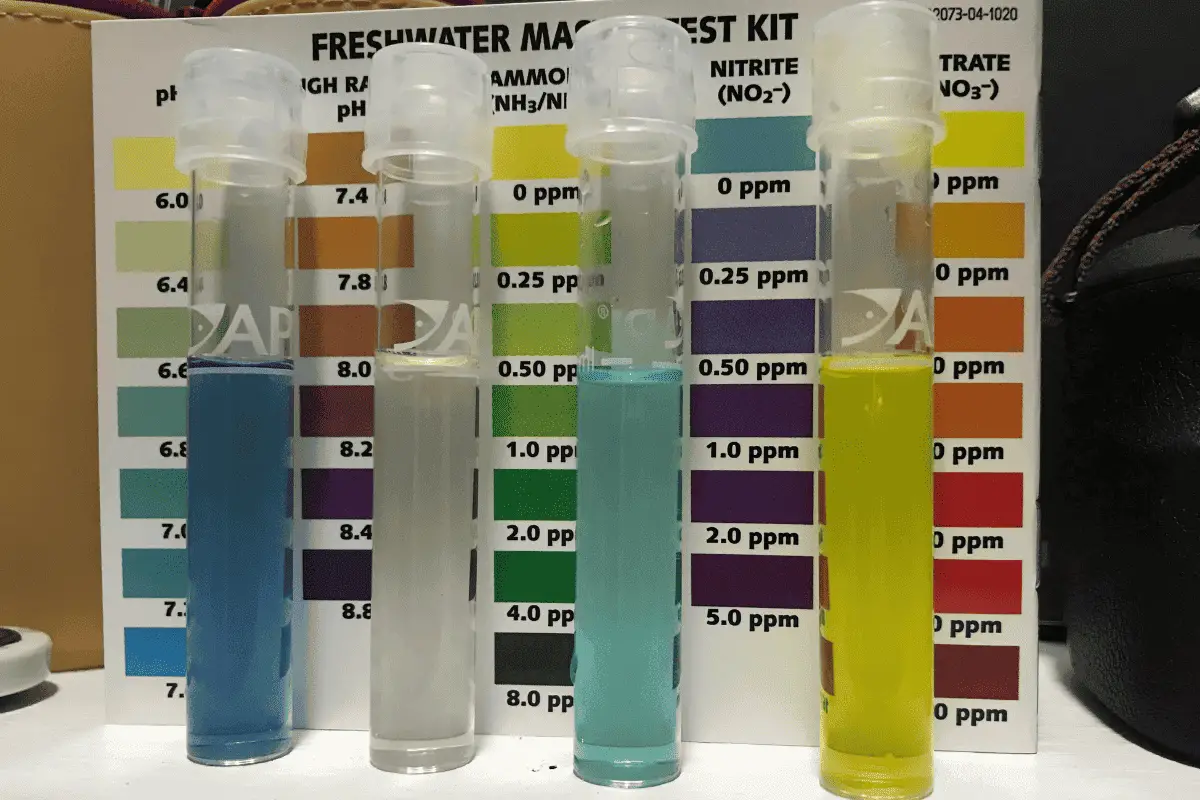Not long ago, I saw my angelfish making lots of bubbles at the top of their tank.
At first, I didn’t really worry about it. But after a few days, my fish didn’t seem okay, and I started to get worried.
So, I began looking up information to find out more.
In this article, I’m going to talk about why angelfish keep making bubbles, what you can do to help, and how to know if your fish isn’t feeling well.
Let’s get into it.

Why Is My Angelfish Blowing Bubbles at the Top?
There could be a couple of reasons why your angelfish is making a lot of bubbles at the top of the tank:
1. Oxygen Deprivation
Angelfish, like many fish species, need adequate oxygen levels in their tank to thrive. When oxygen levels are too low, they may blow bubbles at the surface as they try to get more air.
- Increased Surface Activity: Angelfish will spend more time at the water’s surface, gasping for air, which is not typical behavior for these usually mid-water dwellers.
- Lethargic Movements: The fish may appear less active or sluggish, indicating that their body is not receiving enough oxygen.
- Other Signs: Look for rapid gill movements or fish congregating near the water filter output, where oxygen concentration is higher.
2. Breeding Behavior
Breeding is a natural instinct for angelfish, and bubble-blowing can be part of their mating rituals. Males often blow bubbles to create a nest for eggs.
- Bubble Nest Creation: Male angelfish blow bubbles to form a nest where the female will lay her eggs, a common behavior in breeding.
- Pairing Up: During breeding season, you might notice angelfish pairing off and displaying more vivid colors or territorial behavior.
- Other Signs: Watch for angelfish cleaning a particular area of the tank, as this is where they might plan to lay the eggs.

3. Stress or Anxiety
Stress in angelfish can be caused by various factors, leading to unusual behaviors like blowing bubbles at the water’s surface.
- Sudden Environmental Changes: Rapid changes in water temperature, pH, or lighting can stress angelfish, leading to bubble-blowing as a stress response.
- Aggressive Tank Mates: If the angelfish feels threatened by other fish, it might blow bubbles as a sign of distress.
- Other Signs: Look for changes in eating habits or coloration, as these are also indicators of stress in fish.
Also Read: Stress In Angelfish
4. Water Quality Issues
Poor water quality is detrimental to angelfish health and can result in behaviors like bubble-blowing as a sign of discomfort.
- High Ammonia or Nitrite Levels: Toxic substances in the water, like ammonia or nitrites, can cause respiratory distress, leading to bubble-blowing.
- Unbalanced pH Levels: Incorrect pH levels can stress angelfish, prompting them to seek relief at the water’s surface.
- Other Signs: Cloudy water, foul odor, or visible algae growth can also indicate water quality issues.
5. Disease or Illness
Disease or illness can cause angelfish to blow bubbles due to discomfort or as part of a symptom of the ailment.
- Respiratory Infections: Certain infections can affect the angelfish’s gills, leading them to blow bubbles as they struggle to breathe.
- Parasitic Infestations: Parasites, like gill flukes, can cause discomfort and abnormal behaviors like bubble-blowing.
- Other Signs: Look for other symptoms like clamped fins, spots on the body, or erratic swimming, which can indicate illness.
Also Read: Angelfish Breathing Fast

What Should I Do If My Angelfish Blows Bubbles?
If your angelfish keeps producing bubbles regularly, here are a few steps you can follow:
1. Check and Adjust Oxygen Levels
Adequate oxygenation is essential for angelfish, and low levels can cause them to blow bubbles as a stress response.
- Increase Aeration: Install a stronger air pump or additional air stones; for a 50-gallon tank, aim for an air pump rated for 60-70 gallons. I personally installed this Hygger Aquarium Air Stone (link to Amazon).
- Reduce Water Temperature: Lower the temperature to around 76-78°F, as cooler water (within this range) holds more oxygen.
- Lessen Tank Population: Keep the fish population to a minimum, ideally one angelfish per 10 gallons of water to ensure ample oxygen.
- Add Live Plants: Incorporate oxygenating plants like Elodea or Hornwort which release substantial oxygen during the day.
If you want an accurate measurement of the oxygen levels in your tank, you can readily achieve this using items such as the Monitor DISSOLVED Oxygen Test KIT (link to Amazon).
Here’s a table that shows how much oxygen in the water affects the chances of aquarium animals staying alive:
| Dissolved Oxygen Levels (mg/L) | Survivability |
| < 3 mg/L | Very Low (Immediate action required) |
| 3-4 mg/L | Low (Stressful for most fish) |
| 5-6 mg/L | Moderate (Suitable for many species) |
| 7-8 mg/L | High (Ideal for most aquarium fish) |
| > 8 mg/L | Very High (Optimal for high oxygen-demand species) |
Also Read: Do Angelfish Need A Bubbler?

2. Monitor for Breeding Signs
Breeding behaviors in angelfish, like bubble nest building, are crucial to observe for successful spawning and healthy fry.
- Watch for Pairing: Observe if two angelfish are frequently swimming together or cleaning a specific area, indicating readiness for egg laying.
- Provide Optimal Breeding Conditions: Maintain the water temperature between 76-82°F and pH levels around 6.8-7.0, ideal for angelfish breeding.
- Create a Safe Breeding Environment: Add fine-leaved plants or spawning slates to give angelfish a suitable place to lay eggs.
- Ensure Balanced Diet: Feed a variety of high-quality foods, including live or frozen foods, to ensure the angelfish are in prime breeding condition.
Also Read: Angelfish Breeding Guide

3. Assess and Reduce Stress Factors
Stress can lead to various health issues in angelfish, including bubble-blowing due to discomfort or fear.
- Adjust Lighting: Maintain a consistent lighting schedule, with 10-12 hours of light mimicking natural daylight.
- Reduce Noise and Vibration: Position the tank in a low-traffic area, away from TVs or speakers, to minimize stress.
- Provide Hiding Spaces: Add structures like driftwood or caves, ensuring at least one hiding spot per angelfish. My recommendation: Majoywoo Natural Driftwood (link to Amazon).
- Maintain Consistent Water Parameters: Keep the water temperature steady at 76-82°F and pH between 6.8 and 7.8.
4. Test and Improve Water Quality
Maintaining excellent water quality is crucial for the health of angelfish and can prevent stress-induced behaviors.
- Regular Water Testing: Use a test kit to check ammonia (keep at 0 ppm), nitrites (0 ppm), nitrates (<20 ppm), and pH (6.8-7.8).
- Frequent Water Changes: Perform 20-25% water changes bi-weekly for tanks up to 50 gallons to maintain water quality.
- Use Water Conditioners: Add a water conditioner with every water change to neutralize chlorine and heavy metals. My recommendation: Tetra AquaSafe (link to Amazon).
- Filter Maintenance: Clean or replace filter media every 2-4 weeks, depending on the filter type and tank size.
Also Read: Angelfish Water Parameters

5. Observe for Symptoms of Disease and Consult a Veterinarian
Persistent bubble-blowing combined with other symptoms might indicate a health issue in your angelfish.
- Check for Physical Changes: Examine for white spots (ich), fin rot (frayed fins), or bloating for potential diseases.
- Monitor Eating Habits: Be alert if your angelfish stops eating or shows a decreased appetite over several days.
- Observe Swimming Patterns: Look for unusual swimming like darting or rubbing against objects, which can indicate discomfort.
- Consult a Veterinarian: If symptoms persist, consult a veterinarian familiar with tropical fish diseases for targeted treatment.
While you’re waiting for a diagnosis, you can try using non-prescription products like Seachem PolyGuard (link to Amazon) as a temporary treatment.
These products are designed to help with a variety of health issues.
Also Read: Angelfish Diseases
Bubble Nest vs. Sign of Distress: How to Tell?
Determining whether bubbles in your angelfish tank are part of a bubble nest or a sign of distress involves careful observation of the fish’s behavior and the tank’s conditions.
A bubble nest is a breeding behavior, while bubbles due to distress are often linked to environmental factors or health issues.
- Location of Bubbles: Breeding nests are usually found near the surface, often against tank decorations or plants, while distress bubbles are scattered or at various water levels.
- Consistency of Bubbles: A bubble nest is a cohesive cluster of bubbles, whereas distress-related bubbles are often sparse and irregularly formed.
- Fish Behavior: During nesting, male angelfish guard the nest area and are more territorial, while distressed fish might gasp at the surface or act lethargically.
- Water Conditions: Poor water conditions (e.g., high ammonia levels) can cause distress bubbles; regularly test water parameters to check.
- Other Fish in the Tank: If multiple fish are blowing bubbles or showing signs of stress (like erratic swimming), it’s likely not breeding behavior.
Also Read: Why Is My Angelfish Twitching?

Is It Common for Angelfish to Blow Bubbles on Their Eggs?
Yes, it is common for angelfish to blow bubbles on their eggs.
This behavior is part of their breeding process, where the male angelfish creates a bubble nest and then tends to the eggs by gently blowing bubbles on them.
These bubbles help to keep the eggs oxygenated and free from debris, ensuring a higher chance of successful hatching.
How Else Can I Know If My Angelfish Doesn’t Have Enough Oxygen?
If your angelfish doesn’t have enough oxygen, they will exhibit certain behaviors and physical signs that are quite noticeable.
Besides blowing bubbles at the top, there are other indications to look out for.
- Rapid Gill Movement: If your angelfish’s gills are moving faster than normal, it’s a sign they’re struggling to extract enough oxygen from the water.
- Lethargic Behavior: A lack of oxygen can make angelfish sluggish or less active than usual, often staying at the bottom of the tank.
- Gasping at Surface: Angelfish gasping for air at the water’s surface is a clear indicator of oxygen deprivation in the tank.
- Decreased Appetite: Oxygen-deprived fish often lose interest in food, which is a sign of their discomfort and stress.

What Else Can Cause Bubbles at the Top of the Tank?
Bubbles at the top of the tank aren’t always caused by angelfish. Various factors can contribute to bubble formation, some of which might be unrelated to your fish’s behavior.
- Filtration System: A powerful filter can cause turbulence in the water, leading to the formation of bubbles at the surface of the tank.
- Decaying Organic Matter: Decomposing plants or uneaten food can produce gas as they break down, resulting in bubble formation.
- Chemical Reactions: Certain water treatments or medications can cause a chemical reaction that produces bubbles when added to the tank.
- Temperature Fluctuations: Rapid changes in water temperature can lead to gas solubility changes, causing bubbles to form at the surface.
Conclusions
For quick readers, here’s a short summary:
- Angelfish blowing bubbles can indicate oxygen deprivation, evident from increased surface activity, lethargic movements, and rapid gill movements.
- Bubble-blowing in angelfish might be a breeding behavior, characterized by bubble nest creation, pairing up, and territorial behavior.
- Stress or anxiety in angelfish, due to environmental changes or aggressive tank mates, can also lead to bubble-blowing, along with changes in eating habits and coloration.
- Poor water quality, like high ammonia or nitrite levels and unbalanced pH, can cause angelfish to blow bubbles, with additional signs like cloudy water and foul odor.
- Angelfish blowing bubbles might be a symptom of disease or illness, indicated by respiratory infections, parasitic infestations, and physical changes like clamped fins or erratic swimming.
